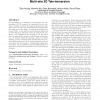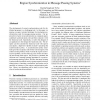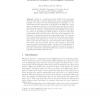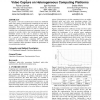76
Voted
CDC
2009
IEEE
15 years 5 months ago
2009
IEEE
Abstract— In this paper we consider the problem of constructing a distributed feedback law to achieve synchronization for a group of k agents whose states evolve on SO(n) and whi...
CDC
2009
IEEE
15 years 5 months ago
2009
IEEE
— In this paper, we address a motion synchronization problem in SE(3) and present a novel passivity based visual feedback system. Though a passivity based control law to achieve ...
NOSSDAV
2010
Springer
15 years 5 months ago
2010
Springer
Synchronization is a challenge in the multi-site 3D teleimmersion (3DTI) because it is complicated by the coexistence of highly correlated heterogenous streams from multiple sourc...
104
Voted
MDM
2010
Springer
15 years 5 months ago
2010
Springer
—Current smartphones have a storage capacity of several gigabytes. More and more information is stored on mobile devices. To meet the challenge of information organization, we tu...
SPAA
2010
ACM
15 years 5 months ago
2010
ACM
Traditional data structure designs, whether lock-based or lock-free, provide parallelism via fine grained synchronization among threads. We introduce a new synchronization paradi...
ICPP
2002
IEEE
15 years 5 months ago
2002
IEEE
The development of correct synchronization code for distributed programs is a challenging task. In this paper, we propose an aspect oriented technique for developing synchronizati...
82
Voted
CEEMAS
2003
Springer
15 years 5 months ago
2003
Springer
Agents of a multi-agent system (MAS) must synchronize whenever they want to perform simultaneous actions. In situated MASs, typically, the control over such synchronization is cent...
88
Voted
MM
2003
ACM
15 years 5 months ago
2003
ACM
We propose a universal synchronization scheme for distributed audio-video capture on heterogeneous computing devices such as laptops, tablets, PDAs, cellular phones, audio recorde...
PVM
2004
Springer
15 years 5 months ago
2004
Springer
The one-sided communication operations in MPI are intended to provide the convenience of directly accessing remote memory and the potential for higher performance than regular poin...
87
Voted
PATMOS
2004
Springer
15 years 5 months ago
2004
Springer
Synchronization between independently clocked regions in a high performance system is often subject to latencies of more than one clock cycle. We show how the latency can be reduce...




